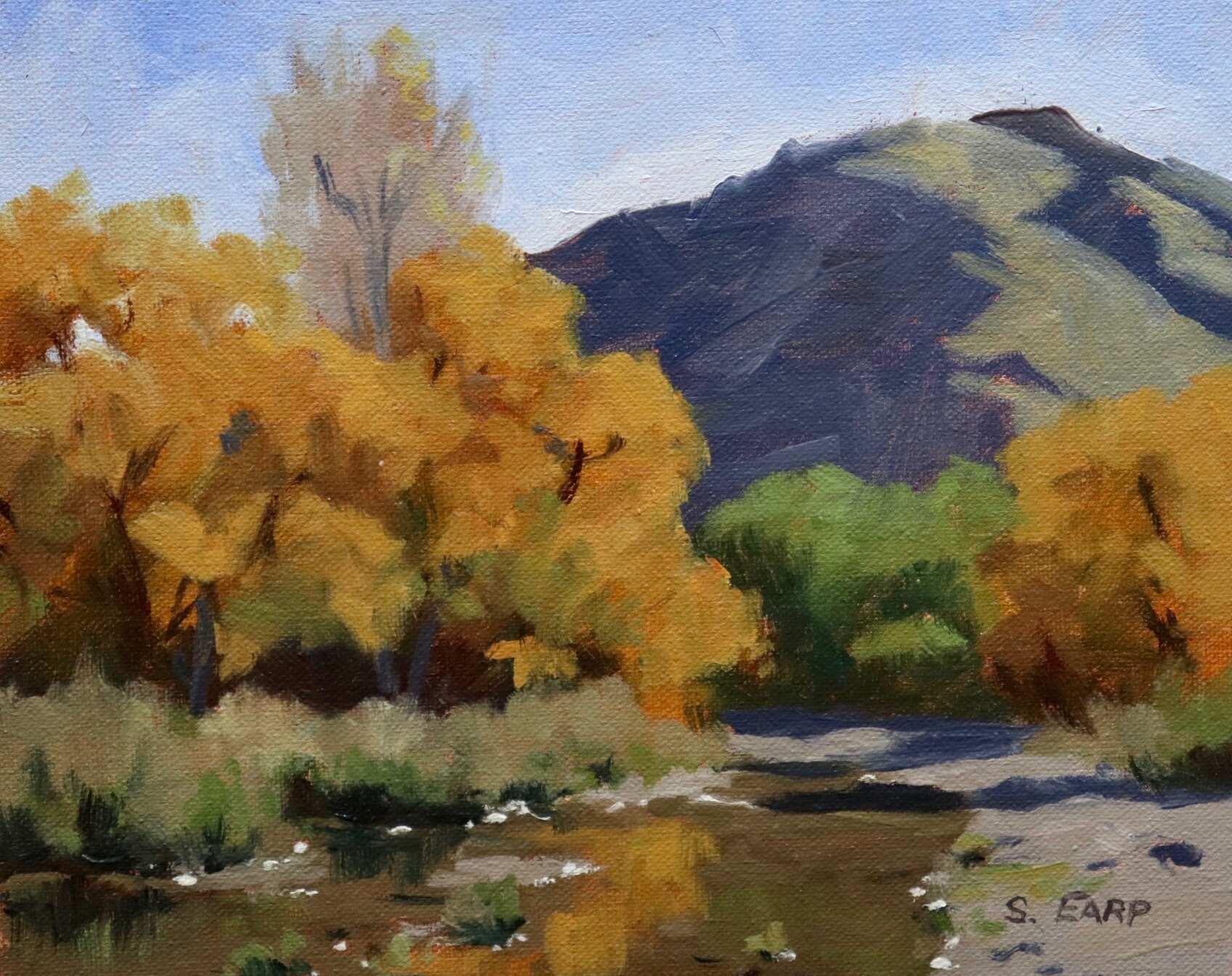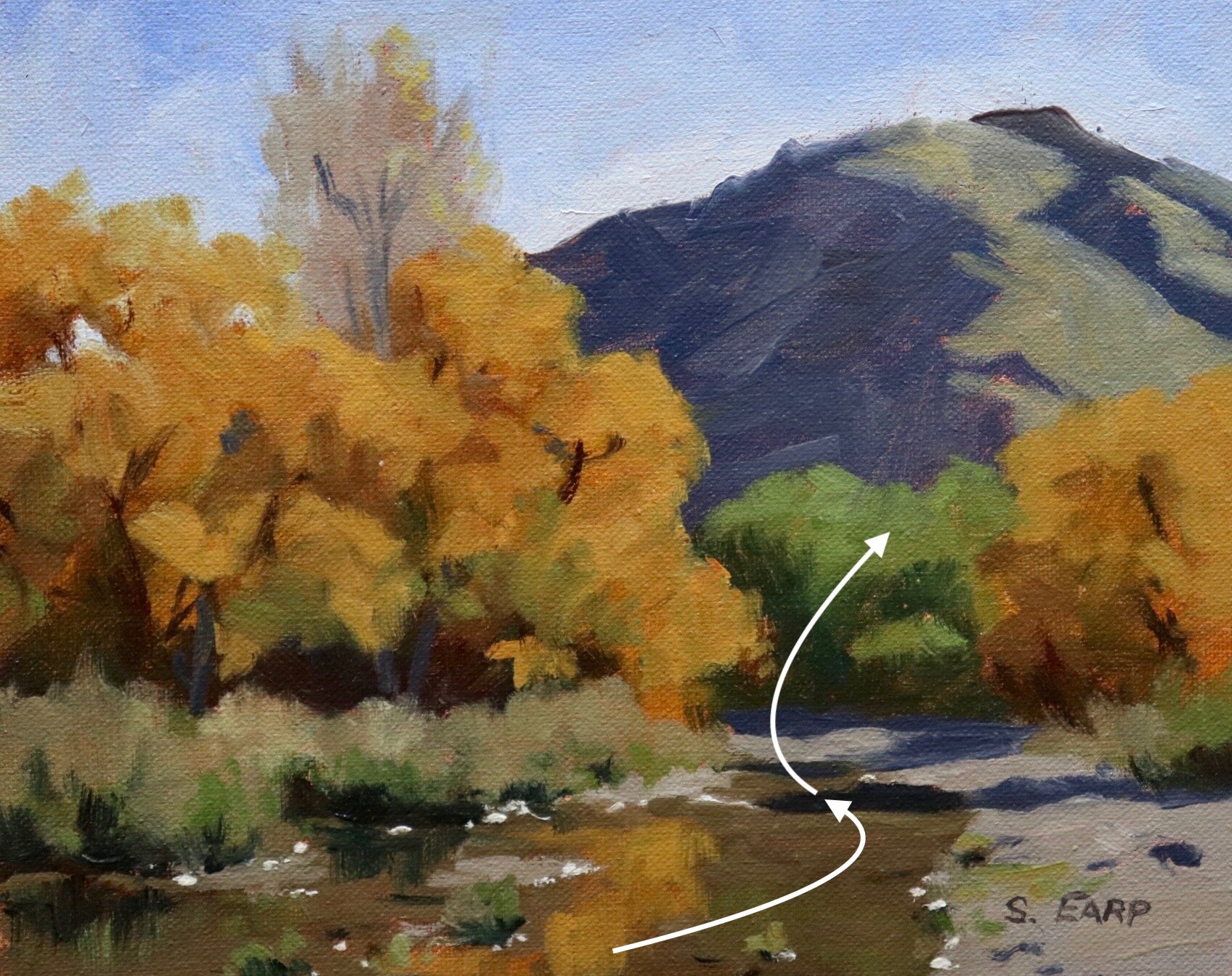
Autumn is a beautiful time of year when all the trees are turning colour and displaying fiery yellows and reds. For me it’s a time of year when I want to get outdoors with my pochade box easel and paint trees from life.
In this blog post I show you how to paint a woodland scene with autumn willow trees. I painted this art work outdoors en plein air in order to capture the vibrant autumn colours first hand.
Whilst my studio paintings are detailed, my plein air paintings feature loose gestural brush marks, therefore this painting tutorial is more about colour and composition rather than detail. However even if you are a studio painter the information in this tutorial is just as applicable to studio work. My paintings always start off in the same way whether it’s a plein air painting or a studio piece.
Painting on Location
This is the view I was painting. The location is in Arrowtown, an area in southern New Zealand that has been planted with European trees by the early British settlers. It’s a beautiful area for painting outdoors.
If you’d like to have a go at painting this please feel free to copy the painting and use the reference photo.

Composition
Whenever I paint outdoors I always think it’s best to simplify the composition, so for this painting I have incorporated and ‘S’ composition. The stream leads the eye towards the green willow tree below the hill in and ‘S’ shape. This helps to add rhythm to the painting. Keep your composition simple!

Colours
I painted this artwork using oil paint and the colours I used in this painting are as follows:
- Titanium white
- Burnt sienna
- Yellow oxide
- Cadmium yellow
- Cadmium red
- Quinacridone crimson
- Ultramarine blue
- Phthalo green
Brushes
Here is a list of the brushes I used in this painting:
- No.6 flat
- No.2 flat
- No.1 round
Painting Tutorial
I am painting on an 18cm x 22cm canvas which I have taped to a panel. I have toned the canvas with a thin layer of burnt sienna back in the studio, which I allowed to dry. The burnt sienna adds vibrancy to the painting.
I sketch out the composition with a No.1 round brush using burnt sienna. I am using Liquin Original as a medium to thin the paint, it also has the advantage of speeding up the drying time.
I make a start on painting the hill in the background. I actually painted the hill that was on the left side of the reference photo as it was more simple. I felt the trees in the background of the main hill would have been too distracting in the composition.
I mix the hill shadow with ultramarine blue, burnt sienna a little quinacridone crimson and titanium white to make the value lighter.
I focus on painting my dark values, accents and shadows first so that it doesn’t matter that the light changes.

I paint the shadows and dark accents in the willow trees and for this I mix ultramarine blue with yellow oxide to create a green cast in the mix. I then round off the mixture with burnt sienna.
For the shadows in the autumn foliage I again mix ultramarine blue with yellow oxide and round off the mixture with burnt sienna. I can increase the saturation of the shadow mix by adding in a little cadmium yellow and cadmium orange.
For the yellow autumn tree foliage I start with a mixture of yellow oxide, cadmium yellow, cadmium orange and then I add a little, burnt sienna and quinacridone crimson. I make the value lighter by mixing in titanium white. I paint the foliage with a No.6 flat brush and I make sure to use the same colour to paint the reflection in the water.
I mix the colour for the silt at the bottom of the water with combination of ultramarine blue, yellow oxide, burnt sienna and titanium white.

The grass along the edge of the water is a pale low chroma brown which I mix using yellow oxide, burnt sienna and titanium white. I then also mix in a little green which I have used for the green grass and the willow tree. I mixed this green using cadmium yellow, ultramarine blue, yellow oxide and titanium white. I also round off the colour with a little cadmium orange and quinacridone crimson which makes the green look more organic.

I paint the sky using a mixture of ultramarine blue and titanium white. I also use my sky mix to fill in negative spaces around the trees and the hill. The sky gets lighter as it nears the horizon so I mix in a little more titanium white in the lower part of the sky.

I add some lighter areas of foliage to the willow trees to create a more 3D form within the tree canopies. I use the exact same colours as I used before to mix the autumn yellow but I mix in a little more titanium white which makes the value a little lighter.
I use my No.1 round brush to paint the suggestion of branches and stems. For this I mix ultramarine blue and burnt sienna which creates a dark tone.

I finish the painting by adding the areas in light on the background hill which I mix using ultramarine blue, yellow oxide, burnt sienna, quinacridone crimson and titanium white. I also use the same colours for the Lombardy poplar tree that has lost all its leaves to indicate fine twigs. I use much more titanium white in the mixture in order to desaturate the colour and create a light tone.
For the shadows that have been cast by the trees I mix ultramarine blue, burnt sienna, quinacridone crimson and titanium white.
I use titanium white straight from the tube to add a few sparkles in the water which I apply with a No.1 round brush. This helps to give the illusion of bright sunlight.

Thanks for reading 😊
